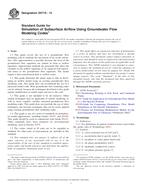Potřebujeme váš souhlas k využití jednotlivých dat, aby se vám mimo jiné mohly ukazovat informace týkající se vašich zájmů. Souhlas udělíte kliknutím na tlačítko „OK“.
ASTM D5719-13
Standard Guide for Simulation of Subsurface Airflow Using Groundwater Flow Modeling Codes (Withdrawn 2022)
Automaticky přeložený název:
Standardní Příručka pro simulaci podpovrchového proudění vzduchu Použití Podzemní Flow modelování kódy
NORMA vydána dne 1.4.2013
Informace o normě:
Označení normy: ASTM D5719-13
Poznámka: NEPLATNÁ
Datum vydání normy: 1.4.2013
Kód zboží: NS-32270
Počet stran: 5
Přibližná hmotnost: 15 g (0.03 liber)
Země: Americká technická norma
Kategorie: Technické normy ASTM
Kategorie - podobné normy:
Anotace textu normy ASTM D5719-13 :
Keywords:
airflow, computer model, groundwater, simulation, soil venting, ICS Number Code 13.060.10 (Water of natural resources),13.080.01 (Soil quality in general)
Doplňující informace
| Significance and Use | ||||||||
|
5.1 The use of vapor extraction systems (VES), also called soil vapor extraction (SVE) or venting systems, is becoming a common remedial technology applicable to sites contaminated with volatile compounds (3, 4). A vapor extraction system is composed of wells or trenches screened within the vadose zone. Air is extracted from these wells to remove organic compounds that readily partition between solid or liquid phases into the gas phase. The volatile contaminants are removed in the gas phase and treated or discharged to the atmosphere. In many cases, the vapor extraction system also incorporates wells open to the atmosphere that act as air injection wells. 5.2 This guide presents approximate
methods to efficiently simulate the movement of air through the
vadose zone. These methods neglect the presence of water and other
liquids in the vadose zone; however, these techniques are much
easier to apply and require significantly less computer hardware
than more robust numerical models.
5.3 This guide should be used by groundwater modelers to approximately simulate the movement of air in the vadose zone. 5.4 Use of this guide to simulate subsurface air movement does not guarantee that the airflow model is valid. This guide simply describes mathematical techniques for simulating subsurface air movement with groundwater modeling codes. As with any modeling study, the modeler must have a thorough understanding of site conditions with supporting data in order to properly apply the techniques presented in this guide. |
||||||||
| 1. Scope | ||||||||
|
1.1 This guide covers the use of a groundwater flow modeling code to simulate the movement of air in the subsurface. This approximation is possible because the form of the groundwater flow equations are similar in form to airflow equations. Approximate methods are presented that allow the variables in the airflow equations to be replaced with equivalent terms in the groundwater flow equations. The model output is then transformed back to airflow terms. 1.2 This guide illustrates the major steps to take in developing an airflow model using an existing groundwater flow modeling code. This guide does not recommend the use of a particular model code. Most groundwater flow modeling codes can be utilized, because the techniques described in this guide require modification to model input and not to the code. 1.3 This guide is not intended to be all inclusive. Other similar techniques may be applicable to airflow modeling, as well as more complex variably saturated groundwater flow modeling codes. This guide does not preclude the use of other techniques, but presents techniques that can be easily applied using existing groundwater flow modeling codes. 1.4 This guide is one of a series of standards on groundwater model applications, including Guides D5447 and D5490. This guide should be used in conjunction with Guide D5447. Other standards have been prepared on environmental modeling, such as Practice E978. 1.5 The values stated in SI units are to be regarded as standard. No other units of measurement are included in this standard. 1.6 This standard does not purport to address all of the safety concerns, if any, associated with its use. It is the responsibility of the user of this standard to establish appropriate safety and health practices and determine the applicability of regulatory limitations prior to use. 1.7 This guide offers an organized collection of information or a series of options and does not recommend a specific course of action. This document cannot replace education or experience and should be used in conjunction with professional judgment. Not all aspects of this guide may be applicable in all circumstances. This ASTM standard is not intended to represent or replace the standard of care by which the adequacy of a given professional service must be judged, nor should this document be applied without consideration of a project's many unique aspects. The word “Standard” in the title of this document means only that the document has been approved through the ASTM consensus process. |
||||||||
| 2. Referenced Documents | ||||||||
|




 Cookies
Cookies
